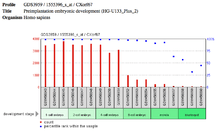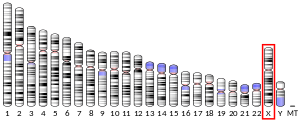CXorf67
Uncharacterized protein CXorf67 is a protein that in humans is encoded by the CXorf67 gene. The Accession Number for the human gene is NM_203407.[3] Aliases include MGC47837 and LOC340602.[4] The gene is located on the positive strand of the X chromosome at Xp11.22.[4] The mRNA is 1939 base pairs long and contains 1 exon and no introns.[5]
| EZHIP | |||||||||||||||||||||||||
|---|---|---|---|---|---|---|---|---|---|---|---|---|---|---|---|---|---|---|---|---|---|---|---|---|---|
| Identifiers | |||||||||||||||||||||||||
| Aliases | EZHIP, chromosome X open reading frame 67, CXorf67, EZH inhibitory protein, KIP75, CATACOMB | ||||||||||||||||||||||||
| External IDs | GeneCards: EZHIP | ||||||||||||||||||||||||
| |||||||||||||||||||||||||
| Orthologs | |||||||||||||||||||||||||
| Species | Human | Mouse | |||||||||||||||||||||||
| Entrez |
| ||||||||||||||||||||||||
| Ensembl |
| ||||||||||||||||||||||||
| UniProt |
| ||||||||||||||||||||||||
| RefSeq (mRNA) |
| ||||||||||||||||||||||||
| RefSeq (protein) |
| ||||||||||||||||||||||||
| Location (UCSC) | Chr X: 51.41 – 51.41 Mb | n/a | |||||||||||||||||||||||
| PubMed search | [2] | n/a | |||||||||||||||||||||||
| Wikidata | |||||||||||||||||||||||||
| |||||||||||||||||||||||||
Expression

Expression of CXorf67 in humans is generally low in all tissues. Higher RNA expression has been reported in the testis and placenta and relatively higher nuclear protein expression has been observed in the placenta, testis and ovarian follicles.[6]
Protein
The translated human CXorf67 protein is 503 amino acids in length.[5] The protein has a molecular weight of 51.9 kdal and an isoelectric point of 10.432[7]
Interactions
Protein interaction of CXorf67 with UBC (polyubiquitin-C) in humans was identified using a two-hybrid screening.[8] Currently no other protein interactions have been identified in humans.
Function
The function of CXorf67 is currently unknown, however the fusion of CXorf67 with the MBTD1 gene has been linked to low-grade endometrial stromal sarcoma in humans.[9] Sequence variants of the chromosomal region Xp11.22 are also predicted to confer susceptibility to prostate cancer in humans.[10]
References
- GRCh38: Ensembl release 89: ENSG00000187690 - Ensembl, May 2017
- "Human PubMed Reference:". National Center for Biotechnology Information, U.S. National Library of Medicine.
- "CXorf67 chromosome X open reading frame 67 [ Homo sapiens (human) ]". NCBI-National Center for Biotechnology Information.
- "Chromosome X Open Reading Frame 67". GeneCards-The Human Gene Compendium.
- "Homo sapiens gene CXorf67, encoding chromosome X open reading frame 67". NCBI-AceView.
- "CXorf67". The Human Protein Atlas.
- "Biology Workbench". SDSC Biology Workbench. Board of Trustees of the University of Illinois.
- Danielsen JM, Sylvestersen KB, Bekker-Jensen S, Szklarczyk D, Poulsen JW, Horn H, Jensen LJ, Mailand N, Nielsen ML (Mar 2011). "Mass spectrometric analysis of lysine ubiquitylation reveals promiscuity at site level". Molecular & Cellular Proteomics. 10 (3): M110.003590. doi:10.1074/mcp.M110.003590. PMC 3047152. PMID 21139048.
- Dewaele B, Przybyl J, Quattrone A, Finalet Ferreiro J, Vanspauwen V, Geerdens E, Gianfelici V, Kalender Z, Wozniak A, Moerman P, Sciot R, Croce S, Amant F, Vandenberghe P, Cools J, Debiec-Rychter M (Mar 2014). "Identification of a novel, recurrent MBTD1-CXorf67 fusion in low-grade endometrial stromal sarcoma". International Journal of Cancer. 134 (5): 1112–1122. doi:10.1002/ijc.28440. PMID 23959973.
- Gudmundsson J, Sulem P, Rafnar T, Bergthorsson JT, Manolescu A, Gudbjartsson D, Agnarsson BA, Sigurdsson A, Benediktsdottir KR, Blondal T, Jakobsdottir M, Stacey SN, Kostic J, Kristinsson KT, Birgisdottir B, Ghosh S, Magnusdottir DN, Thorlacius S, Thorleifsson G, Zheng SL, Sun J, Chang BL, Elmore JB, Breyer JP, McReynolds KM, Bradley KM, Yaspan BL, Wiklund F, Stattin P, Lindström S, Adami HO, McDonnell SK, Schaid DJ, Cunningham JM, Wang L, Cerhan JR, St Sauver JL, Isaacs SD, Wiley KE, Partin AW, Walsh PC, Polo S, Ruiz-Echarri M, Navarrete S, Fuertes F, Saez B, Godino J, Weijerman PC, Swinkels DW, Aben KK, Witjes JA, Suarez BK, Helfand BT, Frigge ML, Kristjansson K, Ober C, Jonsson E, Einarsson GV, Xu J, Gronberg H, Smith JR, Thibodeau SN, Isaacs WB, Catalona WJ, Mayordomo JI, Kiemeney LA, Barkardottir RB, Gulcher JR, Thorsteinsdottir U, Kong A, Stefansson K (Mar 2008). "Common sequence variants on 2p15 and Xp11.22 confer susceptibility to prostate cancer". Nature Genetics. 40 (3): 281–283. doi:10.1038/ng.89. PMC 3598012. PMID 18264098.
External links
- Human CXorf67 genome location and CXorf67 gene details page in the UCSC Genome Browser.

